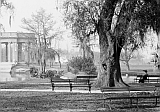|
New Orleans City Park (Images of America) |
|
|
|
~The New Deal: 1929-1939~ |
||

|
The stock market crash of October 29, 1929 marked the beginning of America's Great Depression. Not much improved in
park thereafter until FERA (Federal Emergency Relief Administration established in 1932) did a small amount of work. But when
the WPA (established in 1935) came to the park it became a different place – workers restored, renovated, improved,
and added new buildings, bridges, and roads.. Most of the existing
brick buildings and art deco sculpture, reliefs, and flourishes on buildings, bridges, and fountains was done by WPA artists
and workers who also added new gates, lagoons, benches, shelters, an administration building, 8 roads, 8 bridges, baseball
fields, golf clubhouse additions and new courses, a driving range, a caddy house, stadiums for football and baseball, athletic
fields, and tennis courts with lights for night-play Renovations, repairs, and improvements were made to Roosevelt
Mall, the Rose Garden, the Casino, the Irby Pool, the Peristyle, and sculptures throughout the park. Popp Fountain was completed,
3 bridges rebuilt, City Park Avenue widened, Navarre Road paved, Lelong Avenue repaved, and Anseman Avenue landscaped. The
swampy northern extension was drained and the Couturie Forest established. The lagoons were converted into a stream system
with new drainage. According to Mary Lou Widmer, as a child in the early 1930s her neighborhood grocery store, a cement
floored H.G. Hill on City Park Avenue with traditional corner-store screened doors, took the place of the colorful business
that preceded it in the Saux Building. : :
|
|
|
The images in this book appear courtesy of the New Orleans Public Library (NOPL), Louisiana Digital Library (LDL), the Library of Congress (LOC), The Historic New Orleans Collection (HNOC), Pictometry International (PI), and D.C. "Infrogmation" May (DCM). Unless otherwise noted, images are from the author's collection.
|
||